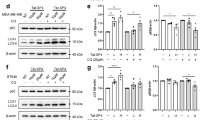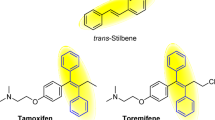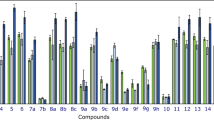Abstract
We have recently reported that cytostatic concentrations of the microsomal antiestrogen-binding site (AEBS) ligands, such as PBPE (N-pyrrolidino-(phenylmethyphenoxy)-ethanamine,HCl) and tamoxifen, induced differentiation characteristics in breast cancer cells through the accumulation of post-lanosterol intermediates of cholesterol biosynthesis. We show here that exposure of MCF-7 (human breast adenocarcinoma cell line) cells to higher concentrations of AEBS ligands triggered active cell death and macroautophagy. Apoptosis was characterized by Annexin V binding, chromatin condensation, DNA laddering and disruption of the mitochondrial functions. We determined that cell death was sterol- and reactive oxygen species-dependent and was prevented by the antioxidant vitamin E. Macroautophagy was characterized by the accumulation of autophagic vacuoles, an increase in the expression of Beclin-1 and the stimulation of autophagic flux. We established that macroautophagy was sterol- and Beclin-1-dependent and was associated with cell survival rather than with cytotoxicity, as blockage of macroautophagy sensitized cells to AEBS ligands. These results show that the accumulation of sterols by AEBS ligands in MCF-7 cells induces apoptosis and macroautophagy. Collectively, these data support a therapeutic potential for selective AEBS ligands in breast cancer management and shows a mechanism that explains the induction of autophagy in MCF-7 cells by tamoxifen and other selective estrogen receptor modulators.
Similar content being viewed by others
Log in or create a free account to read this content
Gain free access to this article, as well as selected content from this journal and more on nature.com
or
Abbreviations
- AEBS:
-
antiestrogen-binding site
- AIF:
-
apopotosis-inducing factor
- Tx:
-
tamoxifen
- 4OHTx:
-
4-hydroxytamoxifen
- PBPE:
-
N-pyrrolidino-(phenylmethyphenoxy)-ethanamine,HCl
- DPPE:
-
N,N′-diethylamino-(phenylmethylphenoxy-ethanamine,HCl
- CHX:
-
cycloheximide
- Act D:
-
actinomycin D
- vit E:
-
vitamin E
- NAC:
-
N-acetylcysteine
- BHT:
-
butylated hydroxytoluene
- zymostenol:
-
5α-cholest-8-en-3βol
- desmosterol:
-
5α-cholest-5,24-dien-3βol
- zymosterol:
-
5α-cholest-8,24-dien-3βol
References
Sutherland RL, Murphy LC, San Foo M, Green MD, Whybourne AM, Krozowski ZS . High-affinity anti-oestrogen binding site distinct from the oestrogen receptor. Nature 1980; 288: 273–275.
Kedjouar B, De Medina P, Oulad-Abdelghani M, Payre B, Silvente-Poirot S, Favre G et al. Molecular characterization of the microsomal tamoxifen binding site. J Biol Chem 2004; 279: 34048–34061.
Brandes LJ . A diphenylmethane derivative selective for the anti-estrogen binding site may help define its biological role. Biochem Biophys Res Commun 1984; 124: 244–249.
Poirot M, De Medina P, Delarue F, Perie JJ, Klaebe A, Faye JC . Synthesis, binding and structure–affinity studies of new ligands for the microsomal anti-estrogen binding site (AEBS). Bioorg Med Chem 2000; 8: 2007–2016.
de Medina P, Favre G, Poirot M . Multiple targeting by the antitumor drug tamoxifen: a structure–activity study. Curr Med Chem Anticancer Agents 2004; 4: 491–508.
Reyno L, Seymour L, Tu D, Dent S, Gelmon K, Walley B et al. Phase III study of N, N-diethyl-2-[4-(phenylmethyl) phenoxy]ethanamine (BMS-217380-01) combined with doxorubicin versus doxorubicin alone in metastatic/recurrent breast cancer: National Cancer Institute of Canada Clinical Trials Group Study MA.19. J Clin Oncol 2004; 22: 269–276.
Raghavan D, Brandes LJ, Klapp K, Snyder T, Styles E, Tsao-Wei D et al. Phase II trial of tesmilifene plus mitoxantrone and prednisone for hormone refractory prostate cancer: high subjective and objective response in patients with symptomatic metastases. J Urol 2005; 174: 1808–1813; discussion 1813.
Liu J, Tu D, Dancey J, Reyno L, Pritchard KI, Pater J et al. Quality of life analyses in a clinical trial of DPPE (tesmilifene) plus doxorubicin versus doxorubicin in patients with advanced or metastatic breast cancer: NCIC CTG Trial MA.19. Breast Cancer Res Treat 2006; 100: 263–271.
Payre B, de Medina P, Boubekeur N, Mhamdi L, Bertrand-Michel J, Terce F et al. Microsomal antiestrogen-binding site ligands induce growth control and differentiation of human breast cancer cells through the modulation of cholesterol metabolism. Mol Cancer Ther 2008; 7: 3707–3718.
Kedjouar B, Daunes S, Vilner BJ, Bowen WD, Klaebe A, Faye JC et al. Structural similitudes between cytotoxic antiestrogen-binding site (AEBS) ligands and cytotoxic sigma receptor ligands. Evidence for a relationship between cytotoxicity and affinity for AEBS or sigma-2 receptor but not for sigma-1 receptor. Biochem Pharmacol 1999; 58: 1927–1939.
Abedin MJ, Wang D, McDonnell MA, Lehmann U, Kelekar A . Autophagy delays apoptotic death in breast cancer cells following DNA damage. Cell Death Differ 2007; 14: 500–510.
Castedo M, Ferri K, Roumier T, Metivier D, Zamzami N, Kroemer G . Quantitation of mitochondrial alterations associated with apoptosis. J Immunol Methods 2002; 265: 39–47.
Bursch W, Ellinger A, Kienzl H, Torok L, Pandey S, Sikorska M et al. Active cell death induced by the anti-estrogens tamoxifen and ICI 164 384 in human mammary carcinoma cells (MCF-7) in culture: the role of autophagy. Carcinogenesis 1996; 17: 1595–1607.
Bursch W, Hochegger K, Torok L, Marian B, Ellinger A, Hermann RS . Autophagic and apoptotic types of programmed cell death exhibit different fates of cytoskeletal filaments. J Cell Sci 2000; 113 (Part 7): 1189–1198.
Klionsky DJ, Abeliovich H, Agostinis P, Agrawal DK, Aliev G, Askew DS et al. Guidelines for the use and interpretation of assays for monitoring autophagy in higher eukaryotes. Autophagy 2008; 4: 151–175.
Tanida I, Minematsu-Ikeguchi N, Ueno T, Kominami E . Lysosomal turnover, but not a cellular level, of endogenous LC3 is a marker for autophagy. Autophagy 2005; 1: 84–91.
Roussi S, Winter A, Gosse F, Werner D, Zhang X, Marchioni E et al. Different apoptotic mechanisms are involved in the antiproliferative effects of 7beta-hydroxysitosterol and 7beta-hydroxycholesterol in human colon cancer cells. Cell Death Differ 2005; 12: 128–135.
Kuwana T, Bouchier-Hayes L, Chipuk JE, Bonzon C, Sullivan BA, Green DR et al. BH3 domains of BH3-only proteins differentially regulate Bax-mediated mitochondrial membrane permeabilization both directly and indirectly. Mol Cell 2005; 17: 525–535.
Pacheco CD, Kunkel R, Lieberman AP . Autophagy in Niemann–Pick C disease is dependent upon Beclin-1 and responsive to lipid trafficking defects. Hum Mol Genet 2007; 16: 1495–1503.
Liao G, Yao Y, Liu J, Yu Z, Cheung S, Xie A et al. Cholesterol accumulation is associated with lysosomal dysfunction and autophagic stress in Npc1−/− mouse brain. Am J Pathol 2007; 171: 962–975.
Rog T, Pasenkiewicz-Gierula M, Vattulainen I, Karttunen M . Ordering effects of cholesterol and its analogues. Biochim Biophys Acta 2009; 1788: 97–121.
Yang C, McDonald JG, Patel A, Zhang Y, Umetani M, Xu F et al. Sterol intermediates from cholesterol biosynthetic pathway as liver X receptor ligands. J Biol Chem 2006; 281: 27816–27826.
Rodriguez-Acebes S, de la Cueva P, Fernandez-Hernando C, Ferruelo AJ, Lasuncion MA, Rawson RB et al. Desmosterol can replace cholesterol in sustaining cell proliferation and regulating the SREBP pathway in a sterol-Delta24-reductase deficient cell line. Biochem J 2009; 420: 305–315.
Samaddar JS, Gaddy VT, Duplantier J, Thandavan SP, Shah M, Smith MJ et al. A role for macroautophagy in protection against 4-hydroxytamoxifen-induced cell death and the development of antiestrogen resistance. Mol Cancer Ther 2008; 7: 2977–2987.
Luciani P, Deledda C, Rosati F, Benvenuti S, Cellai I, Dichiara F et al. Seladin-1 is a fundamental mediator of the neuroprotective effects of estrogen in human neuroblast long-term cell cultures. Endocrinology 2008; 149: 4256–4266.
Kuehnle K, Crameri A, Kalin RE, Luciani P, Benvenuti S, Peri A et al. Prosurvival effect of DHCR24/Seladin-1 in acute and chronic responses to oxidative stress. Mol Cell Biol 2008; 28: 539–550.
Wu C, Miloslavskaya I, Demontis S, Maestro R, Galaktionov K . Regulation of cellular response to oncogenic and oxidative stress by Seladin-1. Nature 2004; 432: 640–645.
Motyl T, Gajewska M, Zarzynska J, Sobolewska A, Gajkowska B . Regulation of autophagy in bovine mammary epithelial cells. Autophagy 2007; 3: 484–486.
Wu Y, Tibrewal N, Birge RB . Phosphatidylserine recognition by phagocytes: a view to a kill. Trends Cell Biol 2006; 16: 189–197.
Atabai K, Sheppard D, Werb Z . Roles of the innate immune system in mammary gland remodeling during involution. J Mammary Gland Biol Neoplasia 2007; 12: 37–45.
Collaborative Group on Hormonal Factors in Breast Cancer. Breast cancer and breastfeeding: collaborative reanalysis of individual data from 47 epidemiological studies in 30 countries, including 50302 women with breast cancer and 96973 women without the disease. Lancet 2002; 360: 187–195.
Etienne MC, Milano G, Fischel JL, Frenay M, Francois E, Formento JL et al. Tamoxifen metabolism: pharmacokinetic and in vitro study. Br J Cancer 1989; 60: 30–35.
Truchet I, Jozan S, Guerrin M, Mazzolini L, Vidal S, Valette A . Interconnections between E2-dependent regulation of cell cycle progression and apoptosis in MCF-7 tumors growing on nude mice. Exp Cell Res 2000; 254: 241–248.
de Medina P, Boubekeur N, Balaguer P, Favre G, Silvente-Poirot S, Poirot M . The prototypical inhibitor of cholesterol esterification, Sah 58-035 [3-[decyldimethylsilyl]-n-[2-(4-methylphenyl)-1-phenylethyl]propanamide], is an agonist of estrogen receptors. J Pharmacol Exp Ther 2006; 319: 139–149.
Biederbick A, Kern HF, Elsasser HP . Monodansylcadaverine (MDC) is a specific in vivo marker for autophagic vacuoles. Eur J Cell Biol 1995; 66: 3–14.
Lavieu G, Scarlatti F, Sala G, Carpentier S, Levade T, Ghidoni R et al. Regulation of autophagy by sphingosine kinase 1 and its role in cell survival during nutrient starvation. J Biol Chem 2006; 281: 8518–8527.
Petiot A, Ogier-Denis E, Blommaart EF, Meijer AJ, Codogno P . Distinct classes of phosphatidylinositol 3′-kinases are involved in signaling pathways that control macroautophagy in HT-29 cells. J Biol Chem 2000; 275: 992–998.
Acknowledgements
This work was supported by an internal grant from INSERM, the Institut Claudius Regaud, the Conseil Regional Midi-Pyrénnées, the Institut National du Cancer through the ResisTH network and the company Affichem.
Author information
Authors and Affiliations
Corresponding author
Additional information
Edited by D Klionsky
Rights and permissions
About this article
Cite this article
de Medina, P., Payré, B., Boubekeur, N. et al. Ligands of the antiestrogen-binding site induce active cell death and autophagy in human breast cancer cells through the modulation of cholesterol metabolism. Cell Death Differ 16, 1372–1384 (2009). https://doi.org/10.1038/cdd.2009.62
Received:
Revised:
Accepted:
Published:
Issue date:
DOI: https://doi.org/10.1038/cdd.2009.62
Keywords
This article is cited by
-
Structural basis for human sterol isomerase in cholesterol biosynthesis and multidrug recognition
Nature Communications (2019)
-
Dendrogenin A drives LXR to trigger lethal autophagy in cancers
Nature Communications (2017)
-
Dendrogenin A arises from cholesterol and histamine metabolism and shows cell differentiation and anti-tumour properties
Nature Communications (2013)
-
microRNA-101 is a potent inhibitor of autophagy
The EMBO Journal (2011)
-
Microsomal epoxide hydrolase expression in the endometrial uterine corpus is regulated by progesterone during the menstrual cycle
Journal of Molecular Histology (2010)



